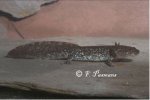Normal 65 F? That would depend on the species, namely whether they're lotic (running water) or lentic (still water) breeders. H. boulengeri breeds in cool mountain streams, unlike your H. tokyoensis, for example, for which the water temperature needn't be that low (though I don't have the natural temperature range for tokyoensis at my fingertips). In the natural habitat of boulengeri, or so I read, the water temperature doesn't exceed 18 C (64 F) even in the summer, and they breed when its around 9 C (48 F). Also, the water must be fresh and clean, which is why I change it at least once a day, usually twice, with water of the same temperature (which is why there's always a bottle of water in the vegetable compartment along with the eggs). I would guess that Pachyhynobius egg sacs also require cool, fresh water...









